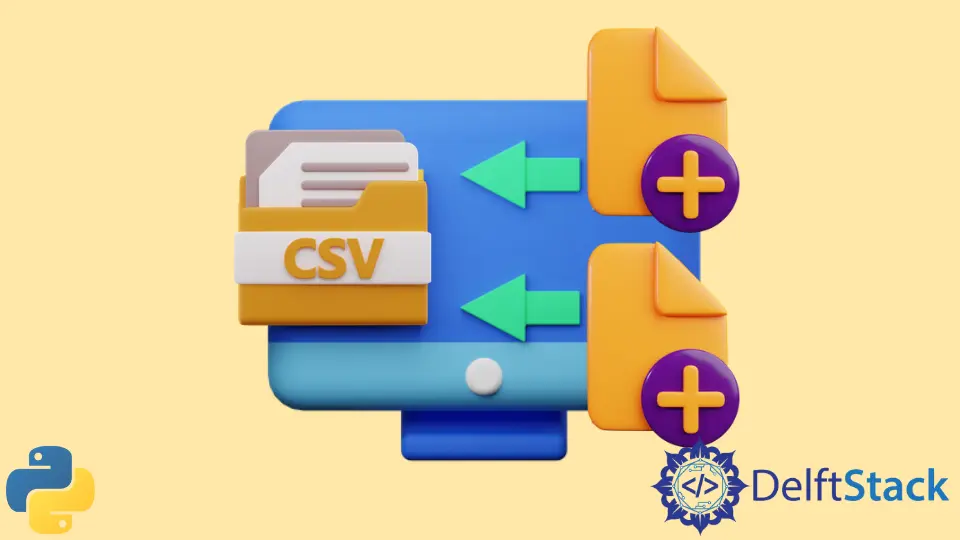Agregar nueva fila a un archivo CSV en Python
-
Agregar datos en la lista al archivo CSV en Python usando
writer.writerow() -
Agregar datos en el diccionario al archivo CSV en Python usando
DictWriter.writerow()

Si desea agregar una nueva fila a un archivo CSV en Python, puede usar cualquiera de los siguientes métodos.
- Asigne los datos de la fila deseada a una lista. Luego, agregue los datos de esta Lista al archivo CSV usando
writer.writerow(). - Asigne los datos de la fila deseada en un diccionario. Luego, agregue los datos de este diccionario al archivo CSV usando
DictWriter.writerow().
Agregar datos en la lista al archivo CSV en Python usando writer.writerow()
En este caso, antes de agregar la nueva fila al archivo CSV anterior, debemos asignar los valores de la fila a una lista.
Por ejemplo,
list = ["4", "Alex Smith", "Science"]
A continuación, pase estos datos de la Lista como un argumento a la función writerow() del objeto CSV writer().
Por ejemplo,
csvwriter_object.writerow(list)
Prerrequisitos:
-
La clase CSV
writerdebe importarse desde el móduloCSV.from csv import writer -
Antes de ejecutar el código, el archivo CSV debe cerrarse manualmente.
Ejemplo: agregar datos en la lista al archivo CSV usando writer.writerow()
Aquí hay un ejemplo del código que muestra cómo se pueden agregar los datos presentes en una lista en un archivo CSV:
# Pre-requisite - Import the writer class from the csv module
from csv import writer
# The data assigned to the list
list_data = ["03", "Smith", "Science"]
# Pre-requisite - The CSV file should be manually closed before running this code.
# First, open the old CSV file in append mode, hence mentioned as 'a'
# Then, for the CSV file, create a file object
with open("CSVFILE.csv", "a", newline="") as f_object:
# Pass the CSV file object to the writer() function
writer_object = writer(f_object)
# Result - a writer object
# Pass the data in the list as an argument into the writerow() function
writer_object.writerow(list_data)
# Close the file object
f_object.close()
Supongamos que antes de ejecutar el código; el antiguo archivo CSV contiene el siguiente contenido.
ID,NAME,SUBJECT
01,Henry,Python
02,Alice,C++
Una vez que se ejecuta el código, se modificará el archivo CSV.
ID,NAME,SUBJECT
01,Henry,Python
02,Alice,C++
03,Smith,Science
Agregar datos en el diccionario al archivo CSV en Python usando DictWriter.writerow()
En este caso, antes de agregar la nueva fila al archivo CSV anterior, asigne los valores de la fila a un diccionario.
Por ejemplo,
dict = {"ID": 5, "NAME": "William", "SUBJECT": "Python"}
A continuación, pase estos datos del diccionario como un argumento a la función writerow() del objeto DictWriter() del diccionario.
Por ejemplo,
dictwriter_object.writerow(dict)
Prerrequisitos:
-
La clase
DictWritertiene que ser importada desde el móduloCSV.from csv import DictWriter -
Antes de ejecutar el código, el archivo CSV debe cerrarse manualmente.
Ejemplo: anexar datos en el diccionario a un archivo CSV usando DictWriter.writerow()
Aquí hay un ejemplo del código que muestra cómo se pueden agregar los datos presentes en un diccionario en un archivo CSV.
# Pre-requisite - Import the DictWriter class from csv module
from csv import DictWriter
# The list of column names as mentioned in the CSV file
headersCSV = ["ID", "NAME", "SUBJECT"]
# The data assigned to the dictionary
dict = {"ID": "04", "NAME": "John", "SUBJECT": "Mathematics"}
# Pre-requisite - The CSV file should be manually closed before running this code.
# First, open the old CSV file in append mode, hence mentioned as 'a'
# Then, for the CSV file, create a file object
with open("CSVFILE.csv", "a", newline="") as f_object:
# Pass the CSV file object to the Dictwriter() function
# Result - a DictWriter object
dictwriter_object = DictWriter(f_object, fieldnames=headersCSV)
# Pass the data in the dictionary as an argument into the writerow() function
dictwriter_object.writerow(dict)
# Close the file object
f_object.close()
Supongamos que, antes de ejecutar el código, el archivo CSV antiguo contiene el contenido siguiente.
ID,NAME,SUBJECT
01,Henry,Python
02,Alice,C++
03,Smith,Science
Una vez que se ejecuta el código, se modificará el archivo CSV.
ID,NAME,SUBJECT
01,Henry,Python
02,Alice,C++
03,Smith,Science
04,John,Mathematics